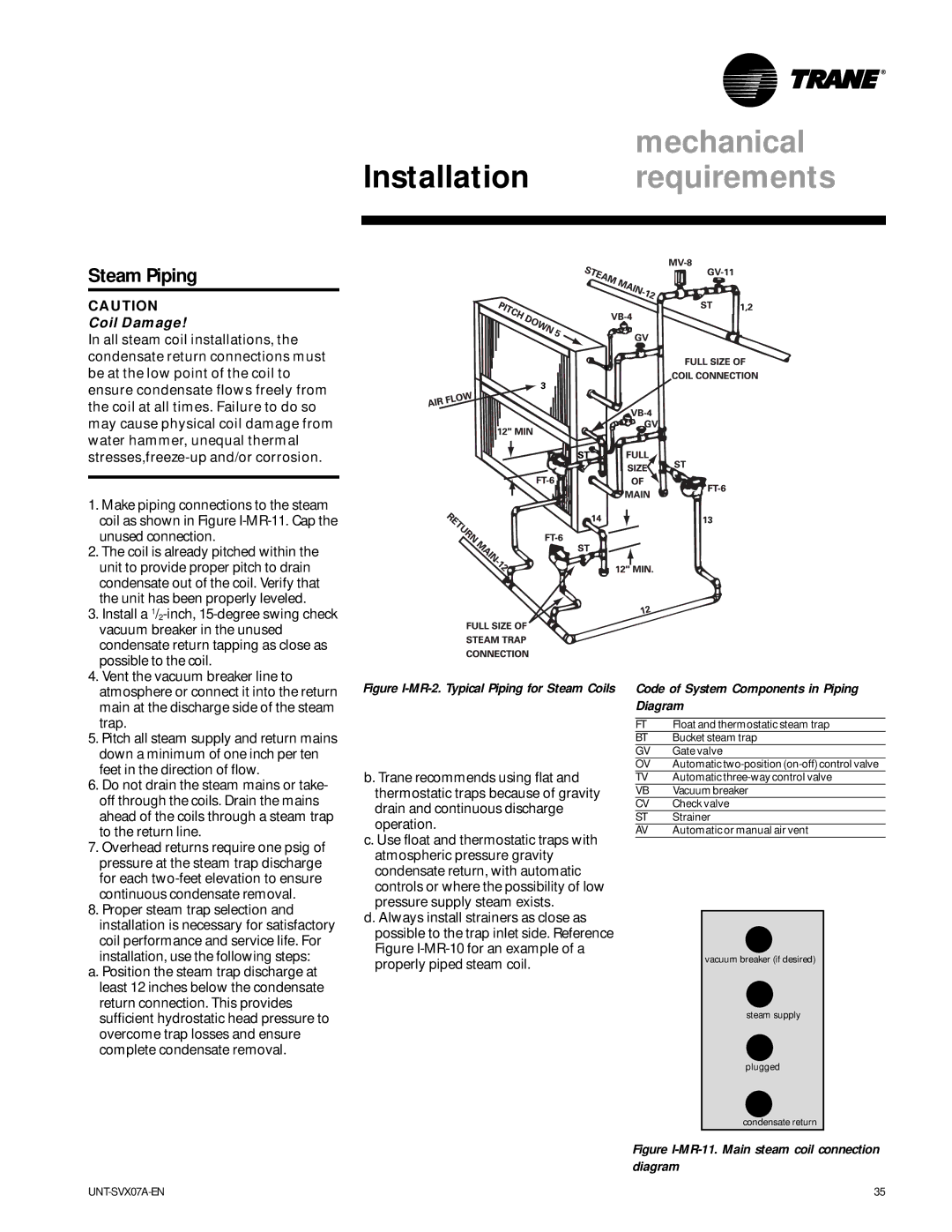Models FC & FF ZO and later design sequence
Installation, Operation, and Maintenance
Common Hvac Acronyms
General information
Contents
Model Number
General
Model Number Description
General
Digit 31 control option
Digit 28 auxiliary control valve 0 = none
Digit 29 piping packages 0 = none
Digit 30 control type 0 = none
Table I-GI-2. Low vertical fan-coil component data
Table I-GI-1. Fan-coil component data
Model M inverted vertical cabinet
Available Models
Model E horizontal recessed
Model K low vertical cabinet
Factory-Installed Piping Packages
Vertical Concealed, Model a
Dimensions
Installation Weights
Vertical Concealed Unit Dimensions & weights, in-lbs
Vertical Cabinet, Model B
Vertical Cabinet Unit Dimensions, in-lbs
Horizontal Concealed, Model C
Horizontal Concealed Unit Dimensions, in-lbs
Horizontal Cabinet, Model D
Horizontal Cabinet Unit Dimensions, in-lbs
Horizontal Recessed, Model E
Installation Dimensions Weights
Horizontal Recessed Unit Dimensions, in-lbs
Vertical Wall Hung Cabinet, Model F
Vertical wall hung cabinet unit dimensions & weights, in-lbs
Vertical Recessed, Model H
Vertical Recessed Unit Dimensions, in-lbs
Vertical Slope Top, Model J
Vertical Slope Top Unit Dimensions, in-lbs
Low Vertical Concealed, Model K
Low Vertical Concealed Unit Dimensions, in-lbs
Low Vertical Cabinet, Model L
Low Vertical Cabinet Unit Dimensions, in-lbs
Inverted Vertical Cabinet, Model M
Inverted vertical cabinet unit dimensions & weights, in-lbs
Inverted Vertical Recessed, Model N
Inverted vertical recessed unit dimensions & weights, in-lbs
Fan-Coil Coil Connections Vertical Units Horizontal Units
Horizontal Units Inverted Units
Force Flo Coil Connections Vertical Units
Fresh Air Opening Dimensions, Horizontal Units
Fresh Air Opening Dimensions, Vertical Units
Wall Box
Wall Box Dimensions
Projection Panel
Projection Panel Dimensions
Jobsite Storage
Pre-installation Installation considerations
Installation Preparation
Receiving and Handling
Pre-Installation Checklist
Service Access
Piping Considerations
Connecting field piping to coil
Mechanical
Duct Connections
Condensate Drain
Figure I-MR-4. Close-up view of the changeover sensor
Venting the Hydronic Coil
Figure I-MR-8. Manual circuit setter valve
Balancing The Manual Circuit Setter Valve
Mechanical
Steam Piping
Code of System Components in Piping Diagram
Electrical
Unit Wiring Diagrams
Supply Power Wiring
Wall Mounted Control Interconnection Wiring
Table I-ER-3. Decimal to fractional HP kW conversion
Table I-ER-2. Low vertical free discharge motors, 115 volt
Table I-ER-9. Electric heat kW
Table I-ER-8. Fan-coil electric heat kW
Table I-ER-11. Force Flo single stage, low kW electric heat
Table I-ER-10. Force Flo single-stage, max kW electric heat
Table I-ER-12. Force Flo 2-stage electric heat
Installing the Unit
Installation
Unit Leveling
Figure I-IP-5. Zone sensor only
Figure I-IP-3. Zone sensor with on/cancel Comm jack
Zone Sensor Installation
Installing Wall Mounted Controls
Wiring Instructions
Fan Mode Switch Installation
Unit Leveling
Installation Checklist
Device Addressing
Communication Wiring
Recommended Communication Wiring Practices
Pre-startup
Pre-Startup Checklist
Tracer ZN510 & ZN520 Unit Startup
Installation startup
Relay Board
Manual Fan Mode Switch
General Operation information
General Information
Tracer ZN520 Operation
Fan Mode Switch Operation
Sequence
Tracer ZN010 & ZN510 Operation
Binary Outputs
Binary Inputs
Supply Fan Operation
Fan Mode Switch
Analog Inputs
Zone Sensors
Tracer ZN520 Sequence of Operation
Discharge Air Tempering
Cooling Operation
Heating Operation
Continuous Fan Operation
Fan Mode Operation
Economizer Damper Option
Fan Start on High Speed
Electric Heat Operation
Manual Fresh Air Damper
Binary Outputs
Table O-SO-12. Binary input configurations
Table O-SO-13. Binary output configuration
Data Sharing
Table O-SO-15. Analog inputs
Table O-SO-14. Analog inputs
Zone Sensor
Fan Switch
On/Cancel Buttons
Table O-SO-16. Zone sensor wiring connections
Table M-D-1. Tracer ZN520 Diagnostics
Maintenance diagnostics
Cycling the Fan Switch
Translating Multiple Diagnostics
Resetting Diagnostics
Diagnostic Reset
Table M-D-5. Valves Stay Open
Table M-D-3. Fan outputs do not energize
Table M-D-4. Valves Stay Closed
Table M-D-8. Fresh Air Damper Stays Closed
Table M-D-6. Electric Heat Not Operating
Table M-D-7. Fresh Air Damper Stays Open
Switch SW2 Electric Heat
Maintenance troubleshooting
Troubleshooting the Relay Board
Switch SW1 Controller Type
Yellow Comm LED
Troubleshooting Tracer ZN010, ZN510 & ZN520
Red Service LED
Green Status LED
BOP5 BOP6
Table M-T-1. Test sequence for 1-heat/1-cool configurations
Main Drain Pan
Maintenance
Maintenance Procedures
Winterizing the Coil
Coil Maintenance
Steam and Hydronic Coil Cleaning Procedure
Replacing the Motor
Control Device Replacement
Annual Maintenance
Periodic Maintenance Checklists
Monthly Checklist
Monthly Maintenance
Csti Fan Speed Switch
Typical wiring
Csti Non Fan Speed Switch
Line voltage fan speed switch
Tracer ZN010 with electric heat
Tracer ZN510 with main and auxilliary valves
ZN520 with 2-stage electric heat
Page
Page
Page
PL-TD-UNT-SVX07A-EN

